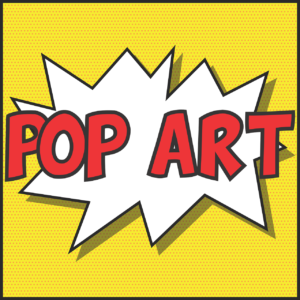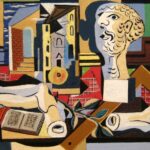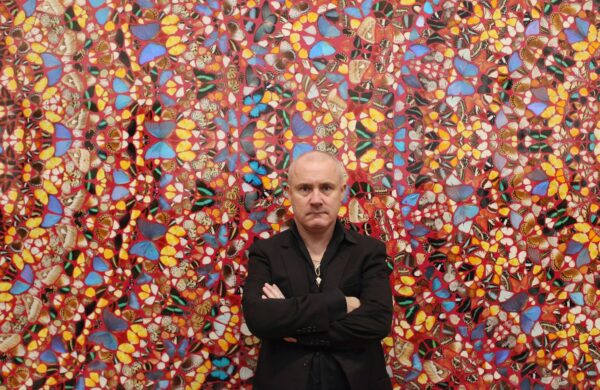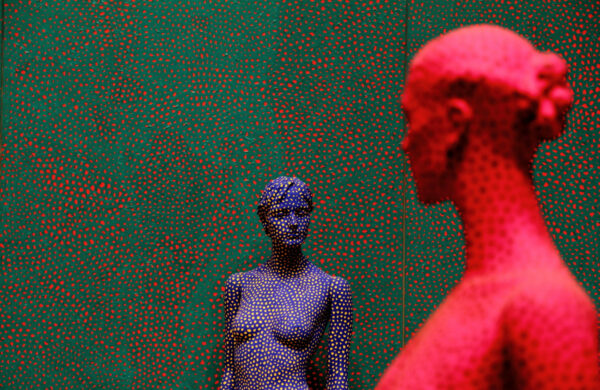The Influence of Pop Culture on Contemporary Art
As someone deeply immersed in the fascinating world of visual culture, I’ve witnessed firsthand the remarkable impact that pop culture has on the evolution of contemporary art. Pop art, a significant art movement that emerged in the midst of the 20th century, defied the conventions of modern art by embracing the ethos of popular consumption and commercial imagery. This bold artistic revolution fostered a nuanced conversation between art movements and the vibrancy of the everyday, encapsulating a culture’s shared experiences and redefining artistic expression.
My exploration into this compelling interplay reveals that contemporary art, informed by the currents of pop culture, transcends mere aesthetic pleasure to broadcast societal narratives. The iconic works of artists like Andy Warhol and Roy Lichtenstein did not merely depict the surface of American life; they delved into the complex dynamics of consumerism and mass media. This synergy has dynamically shaped the trajectory of art as we know it, painting a vivid tableau of our collective values and ideologies.
Key Takeaways
- Pop art’s emergence marked a significant shift in the perception of what constitutes contemporary art.
- The relationship between pop culture and art movements reflects and critiques social trends and consumer behaviour.
- Andy Warhol and Roy Lichtenstein’s contributions were instrumental in defining the visual language and iconography of Pop art.
- Modern art continues to draw from the aesthetic and thematic elements of Pop culture, underscoring its enduring influence.
- The interplay between pop culture and contemporary art highlights the importance of visual culture in articulating the zeitgeist of an era.
Understanding the Impact of Pop Culture on Art Movements
The Pop art movement, with its explosion of vibrant colors and shrewd incorporation of commercial imagery, marked a pivotal moment in the evolution of art. The cultural landscape was undeniably altered as artistic value became a conversation about accessibility rather than exclusivity. Let’s delve into how this genre reshaped art standards and assert its position in the legacy of significant art movements.
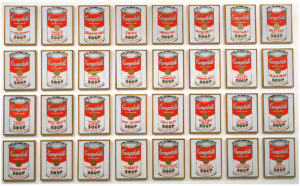 Andy Warhol – Sotheby’s – Pop Art History
Andy Warhol – Sotheby’s – Pop Art History
The Birth and Evolution of Pop Art
When I dissect the trajectory of the Pop art movement, I find it intimately entwined with art movements that preceded it. It began as a bold response to the elite and often inaccessible echelons of traditional art. By plucking objects from the supermarket shelves and comic book pages, artists bridged the gap between mundane consumer goods and high art, and in doing so, revolutionized aesthetic value. This evolution of art manifested a cultural rebellion, one that speaks to a diverse audience rather than a select few.
How Pop Culture Redefines Artistic Value
While examining the fabric of Pop art, it’s evident that aesthetic value transcended the traditional and entered a realm where the ordinary became extraordinary. It wasn’t just the visual aesthetics of products but also their cultural significance that artists emphasized, leading to a redefinition of “artistic value” and the emergence of a new dialogue around art movements and their purposes.
Rebellion Against Traditional Art Standards
The dawning of the Pop art movement felt like a collective turning of backs on rigid art standards. By incorporating elements of Pop culture into their work, artists issued a challenge to the prevailing status quo. It wasn’t just art for art’s sake anymore; it was art for society’s sake—making it both a touchstone for cultural reflection and a beacon signaling the evolution of art toward greater inclusivity.
| Art Movement | Core Characteristics | Impact on Art Standards |
|---|---|---|
| Traditional Fine Art | Elegance, Elitism, Technical Mastery | Set high thresholds for artistic entry |
| Pop Art Movement | Accessibility, Everyday Imagery, Ironic Commentary | Democratized art, making it relevant to everyday life |
| Contemporary Art | Diverse Media, Conceptual Value, Interactive Experience | Continues to expand the definition and boundaries of art |
“Art is what you can get away with.” This quip, often attributed to Andy Warhol, underscores the audacious and transformative ethos at the heart of the Pop art movement—a true emblem of my reflection on art’s dynamic interplay with society.
Celebrating Iconic Pop Artists: Andy Warhol and Roy Lichtenstein
 Roy Lichtenstein, Kiss V (1964)
Roy Lichtenstein, Kiss V (1964)
In the effervescent arena of Pop art, two names invariably stand out, synonymous with a movement that radically transformed artistic expression: Andy Warhol and Roy Lichtenstein. These headlining Pop artists didn’t just paint canvases; they created cultural landmarks that conversed with a society engrossed by consumerism, altering the landscape of contemporary art with their innovative artistic techniques.
Warhol’s Campbell’s Soup Cans: A Symbol of Pop Culture
Andy Warhol’s liaison with mass consumerism birthed the iconic ‘Campbell’s Soup Cans’, effectively elevating the ordinary to art. It’s a visual anthem to Pop culture’s omnipresence, with Warhol co-opting the imagery of mass-produced goods to both favor and critique the consumerist milieu. His work flawlessly mirrors society’s own obsession with brand conformity and uniformity. This series didn’t just capture the zeitgeist; it became an indelible mark upon it.
Lichtenstein’s Comic Influences and Techniques
Roy Lichtenstein’s oeuvre is distinctive for its reliance on comic strip motifs and his use of Artistic techniques mimicking the mechanical process of Benday dots. A pop culture conversation, Lichtenstein’s compositions deal with the paradoxes of pulp fiction dramatization juxtaposed with the fine art tradition, injecting a satirical verve into the gallery spaces.
The Artists’ Shared Commentary on Consumerism
Both Warhol and Lichtenstein wielded their art as countercultural commentary. Never shy to explore the burgeoning consumerist desire of the era, their art became a societal mirror. It offered profound insights into the commodification of desire, wherein the consumer becomes both the buyer and the product in an ever-expansive mercantile reality.
| Artist | Influence | Technique | Commentary |
|---|---|---|---|
| Andy Warhol | Consumer Goods | Silkscreen Printing | Cultural Uniformity |
| Roy Lichtenstein | Comic Strips | Benday Dots | Pulp Fiction Dramatization |
In summation, the convergence of Andy Warhol and Roy Lichtenstein’s artistic visions not only shaped Pop Art but also echoed through the corridors of modern art history. Their seminal creations continue to engage audiences, prompting contemplation on the role consumerism plays within our culture, and how, through the language of Pop Art, its complexities are explored and understood.
![]()
Pop Art’s Reflection of Society’s Fads and Ideals
As a journalist, I’ve often observed the intriguing relationship between Pop Art and Contemporary society. At its core, this artistic movement serves as an Artistic reflection of the culture from which it emerges. Through colorful canvases and innovative designs, Pop Art gives form to Society’s ideals, capturing the spirit of the age.
The prevalence of Fads in Pop Art is particularly telling. By incorporating icons and imagery from the latest trends within fashion and entertainment, artists create a dialogue that resonates with the public. These works become a mirror, reflecting not only the ephemeral nature of trends but also the deeper values they signify.
Let’s consider, for example, the artistic ventures into the realms of literature and cinema. The storytelling devices in these sectors are not merely tales spun for amusement; they often embody the ideological battlegrounds of the times. By borrowing these narratives, Pop Art distills the essence of contemporary conflicts and aspirations into single, impactful images.
Through meticulous observation, I’ve further noted that Pop Art doesn’t shy away from the trivial or the commercialized aspects of life. Instead, it embraces them, turning advertisements, celebrity figures, and brand logos into symbols of societal commentary. This is where the genre truly becomes a barometer for understanding the shifts within our social fabric.
In a world in flux, the constant evolution of what we, as a society, hold dear is encapsulated in the Pop Art of our times. It’s a vibrant genre, ever responsive to the pulse of our collective consciousness, forever chronicling the pages of our cultural history.
Nostalgia and Humor in Pop Art
The canvas of Pop art is rich with colors that pull at the heartstrings of nostalgia while invoking the wittiness of humor. As I delve into the intricacies of Pop artistry, a burgeoning sentiment of generational connection emerges, underscoring how this vibrant form of art captivates and unites audiences through shared cultural experiences.
The appeal of nostalgia in art is undeniable. It transports viewers to bygone eras, evoking memories that bridge the generational divide with visuals that dialogue with past and present alike. Pop art serves as a visual lexicon where cultural icons of the past reemerge, granting a timeless quality to contemporary works.
Connecting Generations through Shared Pop Memories
Generational connection is at the heart of Pop art’s allure. The juxtaposition of iconic imagery from the ’50s next to the tech-savvy symbols of the 21st century creates a cross-generational tapestry, resonating with both Baby Boomers and Millennials. This art form functions as a visual language, enabling people from diverse age groups to communicate through shared symbols and icons distilled into the pop art pieces.
The Satirical Edge of Pop Artistry
Humor in Pop Art is as critical as its palettes and subjects. Satire sharpens this genre’s edge, allowing artists to critique and play with the excesses of consumer culture and societal norms. With this in mind, Pop artistry doesn’t just present what is already known; it reconstructs it with wit, encouraging laughter, thought, and sometimes even discomfort. It compels the audience to question the underpinnings of their everyday lives through the prism of parody and pastiche—a facet that makes Pop Art ever-relevant.
| Element of Pop Art | Nostalgic Influence | Element of Humor |
|---|---|---|
| Iconography | Revival of ’60s comic strips and advertising motifs | Irony in repurposing commercial icons for critical commentary |
| Color Palette | Bold colors harking back to vibrant decades | Exaggerated hues inciting visual puns and gags |
| Subject Matter | Vintage celebrities and obsolete technology rendered in modern context | Juxtaposition of ancient and modern elements to create humorous contrasts |
Modern Technologies and Their Role in Pop Art’s Evolution
The ever-changing landscape of Pop Art is a testament to the powerful impact of modern technologies on this vibrant artistic movement. As a professional deeply invested in analyzing art trends, I’ve observed a seismic shift in the realm of creativity with the integration of artificial intelligence in art. By dissecting the components that define Pop Art’s ongoing transition, it becomes clear how these technological advancements are acting as catalysts for an extraordinary art evolution.
In my explorations, I’ve encountered artists who harness AI to defy traditional boundaries, crafting concepts that still carry the defiant spirit of Pop Art’s origins. This fusion of technology and creativity reflects the genre’s intrinsic link to culture and innovation. Notions of aesthetic and technical prowess are being reexamined, as AI-generated art challenges preconceived notions of authorship and originality. The toolset may be new, but the evocative power of the visuals remains undiluted.
It is within this digital renaissance that new forms of Pop Art are emerging, transforming canvases with a bold new language. The algorithms involved do not simply replicate human creativity; rather, they offer a partnership that pushes the frontiers of the possible. Artists now find themselves becoming orchestrators of creativity, guiding intelligent systems to produce works that buzz with a modern sensibility.
Critical thought and conceptual depth are soaring to the forefront of Pop Art’s evolution—a renaissance spurred by the digital heartbeat of our era.
The trajectory of Pop Art is ascending towards a zenith where the power of an idea is crowned above the stroke of a brush. My journey covets not the nostalgic past but seeks the spark of tomorrow—a horizon where modern technologies and artistic intelligence coalesce under the expansive umbrella of human imagination.
Urban Street Art and Pop Culture’s Influence
In the heart of urban landscapes, where the hustle of city life meets the stillness of static walls, a phenomenon unfolds—a vivid eruption of urban street art, turning the street canvas into a dynamic dialogue with pop culture. This metamorphosis of public spaces into hubs of artistic expression is facilitated by visionaries whose names have become synonymous with street art—Banksy and KAWS. Their contributions have carved out a unique art scene, capturing the essence of cultural commentary and creative flair.
The Street as a Canvas for Pop Expression
The streets, once blank expanses of urban architecture, now serve as sprawling galleries for street artists, who adorn them with bursting colors and eloquent imagery. These artists harness their surroundings as canvases to imprint their perspectives, leveraging striking visuals infused with popular culture motifs. Noteworthy is the approach to utilize spaces that capture high foot traffic, allowing for organic interactions and the democratization of art appreciation.
From Bansky to KAWS: The Urban Impact
The enigmatic Bansky, with a penchant for satirical street art, employs stenciling techniques to voice social and political critiques, cementing urban walls with thought-provoking pieces. KAWS, conversely, integrates commercial icons and cartoon figures into his works, conjuring a nostalgic connection with viewers, while recontextualizing characters within the realms of fine art. Their work not only adorns the cityscape but invigorates the public consciousness, challenging observers to see beyond the surface and engage with underlying messages.
The influence of artists like Bansky and KAWS is measured not just in visual impact, but also in how they’ve propelled street art into a respected echelon of cultural production. These artists’ intricate interplay between anonymity and fame, as well as a high art and popular appeal, exemplifies the compelling nature of urban street art and its indelible mark on contemporary culture.
Pop Art in the Digital Age: Social Media and Virality
Amidst the rush of the digital age, the vibrancy of Pop art has found a new canvas on social media platforms. Here, the confluence of art and technology embodies the epitome of virality in art, making it possible for visual culture to reach unprecedented levels of awareness and engagement. The dynamic interaction among viewers, artists, and their creations underscores how Pop art on social platforms is a burgeoning arena for cultural discourse.
Memes and Digital Art: The New Face of Pop Culture
In my perspective, memes and the proliferation of digital art have forged a novel domain within the Pop art tradition. This digital manifestation retains the core of Pop art—its reflection of contemporary culture—while embracing the instantaneous connectivity that social media affords. It is an exciting evolution of how we experience virality in art and interact with our modern visual narrative.
Artists Leveraging Social Platforms to Showcase Pop Art
Observing the trends, I’ve noticed that artists adeptly navigate the realms of Instagram, Twitter, and even TikTok to broadcast their Pop art creations. Showcasing Pop art on social platforms not only democratizes art consumption but also contributes to the digital narrative that shapes public discourse and perception.
These social networks serve as pulleys elevating artists to new heights of recognition and influence. In this digital era, virality equates to currency, propelling works into the limelight to either bask in momentary fame or cement their place in the annals of art history.
| Social Platform | Use in Pop Art Promotion | Notable Examples |
|---|---|---|
| Visual-centric sharing, hashtags | Artist profiles, curated collections | |
| Real-time engagement, Trending topics | Art-related tweets, Animated GIFs | |
| TikTok | Short-form videos, Challenges | Time-lapse creation videos, Theme-based art challenges |
Peering into the future, I foresee social media continuing to redefine the interplay between pop culture and art. It is here, in the pulsating hub of digital connectivity, that Pop art’s narrative will thrive, morph, and inevitably, reassert its role in mirroring and shaping the ethos of our times.
Graphic Design: The Commercial Cousin of Pop Art
As I delve into the vibrant world where graphic design meets pop art, it’s impossible not to notice how commercial art has evolved, taking a leaf out of the fine art book to redefine its role in the modern branding landscape. This crossover has not only blurred the lines between the two realms but has ignited a creative explosion within the marketplace.
The Aesthetic Crossover between Commercial and Fine Art
Indeed, graphic design has borrowed liberally from its fine art counterpart, adopting bold colors, dynamic compositions, and cultural references that epitomize the spirited essence of pop art. Similarly, pop art has embraced the functionality of graphic design to create artworks that speak to the masses, often in a commercially viable way.
Branding and Pop Art Prints in the Marketplace
Whether it’s a Warhol-inspired product packaging or a Lichtenstein-esque advertising campaign, the infusion of pop art aesthetics into branding has carved out a niche for pop art prints in the marketplace. These artistic commodities bridge the gap between consumer goods and art collectibles, making culturally resonant statements accessible to a wider audience.
Graphic design’s symbiotic relationship with fine art has fostered a marketplace rich with opportunities for artists and designers alike. From logo designs that become iconic symbols to limited edition prints that grace the walls of urban dwellings, the intersection of commercial and fine art continues to shape our visual culture, each element informing and enhancing the other.
Intertextuality: Pop Culture’s Dialogue with Contemporary Art
In the kaleidoscopic world of art, the term intertextuality plays a pivotal role in defining the intricate dance between vibrant pop symbols and the esteemed realms of high art. This synergy extends beyond mere visual appeal, fostering a robust dialogue with contemporary art that is both engaging and insightful. As an aficionado of this dynamic, I’ve witnessed firsthand how pop culture iconography infuses itself into the tapestry of traditional high art, creating a language that transcends time and space.
The Intermix of Pop Symbols and High Art Contexts
Understanding this intermix is akin to unraveling a rich, historical narrative. Pop symbols – the ubiquitous signs of mass culture – once confined to the streets and screens, now sit proudly alongside the venerable works of high art within gallery walls. The iconic works of Keith Haring and Jean-Michel Basquiat serve as exemplars of this crossover; their works encapsulate the raw energy of street art while being celebrated in high-end art markets and institutions.
How Contemporary Art And Pop Culture Borrow and Build on Each Other
The symbiosis between contemporary art and pop culture is a beacon of innovation and creativity. Contemporary artists often borrow elements from popular media, distorting and recontextualizing them to offer a fresh perspective. Conversely, the aesthetic and conceptual elements of high art frequently infiltrate pop culture, thus enriching it. Jeff Koons’ sculptures borrow heavily from pop culture, only to be revered as high art, exemplifying this mutual enrichment. In this creative milieu, the lines between high art and pop culture are not just blurred—they are intertwined, showcasing a robust intertextuality that shapes our cultural lexicon.
Conclusion
As I reflect on the narratives that have emerged from this discourse, the journey of Pop Art has truly been a compelling tale of artistic exploration. From its inception, challenging the pedestals of traditional art to its current reverence as a significant pillar influencing contemporary art, its narrative is drenched in the vivid hues of evolving visual culture. Pop Art exemplifies how art not only mirrors society but also shapes it, knitting pop culture’s threads into the very fabric of our visual dialect.
My gaze towards the future of Pop Art is filled with expectation and curiosity. How will the innovative minds of artists harness the rapidly advancing pace of modern technologies to push the boundaries even further? As artificial intelligence and other digital canvases become normal brushes for creators, we stand on the brink of an era poised to redefine the paradigms of creativity and conceptual value. This perpetual current of ingenuity, I find, is what etches the lasting influence of Pop Art on the ever-dynamic tableau of visual culture.
As we grapple with the undercurrent of consumerism in our global narrative, it intrigues me to ponder how Pop Art will continue to serve as a critical voice. Through bold palettes and even bolder ideas, it is a relentless force in the world of aesthetic expression, inviting both artists and aficionados to revel in the evergreen spirit of rebellion and reflection. In every corner of our evolving visual culture, the pulse of Pop Art beats loudly, promising an endless odyssey of cultural engagement and transformative artistry.
FAQ
What is Pop Art and how does it relate to contemporary art?
Pop Art is an art movement that emerged in the 1950s and 1960s, focusing on themes and techniques drawn from popular culture and mass media. In relation to contemporary art, Pop Art has influenced modern artists by incorporating pop culture references, commercial imagery, and a critique of consumerism, remaining relevant as it continuously evolves with the cultural zeitgeist.
How did the Pop Art movement begin, and why was it significant?
The Pop Art movement began as a response to the elitism of traditional art. Artists like Andy Warhol and Roy Lichtenstein wanted to collapse the boundaries between ‘high’ and ‘low’ culture by incorporating imagery from advertisements, comic books, and everyday products into their works. The movement was significant because it challenged previous conceptions of artistic value and ushered in a new era in which art was more accessible and reflective of contemporary life.
How do Andy Warhol and Roy Lichtenstein’s works reflect their cultural environment?
Warhol and Lichtenstein’s works are deeply rooted in the cultural environment of their time, mirroring the burgeoning consumerism and media saturation. Warhol’s work with products like Campbell’s Soup Cans and celebrity portraits, and Lichtenstein’s comic-strip-based art highlight the omnipresence of advertising and popular culture, providing a critical lens through which to view their impact on society.
What elements of pop culture are most prevalent in Pop Art?
Pop Art draws on a wide array of elements from pop culture, including advertising imagery, comic book styles, brand logos, celebrity culture, television, and everyday consumer goods. These elements are used to both celebrate and critique various aspects of mainstream culture.
How does Pop Art create a sense of nostalgia and humour?
Pop Art generates nostalgia by referencing cultural icons, imagery, and trends that evoke memories of different time periods. The humor in Pop Art often stems from its use of irony, parody, and satire, inviting viewers to laugh while also reflecting critically on the subjects it portrays.
In what ways has modern technology influenced the evolution of Pop Art?
Modern technology, especially artificial intelligence, has influenced the evolution of Pop Art by enabling the creation of artworks that challenge traditional methods of production and aesthetics. Technology has also facilitated new forms of artistic expression and distribution, such as digital art, allowing Pop Art to remain cutting-edge and relevant.
What role does urban street art play in the dialogue between Pop Art and pop culture?
Urban street art acts as a public platform for expressing the dynamics of pop culture. It carries forward the legacy of Pop Art by making art accessible to all and using visual language that includes graphic design, pop culture references, and political messages to engage with a wider audience and comment on contemporary issues.
How have social media and the digital age impacted Pop Art?
Social media and digital technology have revolutionized the way Pop Art is created, shared, and consumed. Artists can now reach a global audience instantly, utilize digital tools to create new forms of art, and engage with viewers directly through platforms like Instagram, making Pop Art an interactive experience and extending its influence tremendously.
What is the relationship between graphic design and Pop Art?
Graphic design and Pop Art share a symbiotic relationship with a strong aesthetic crossover; both employ bold colors, clear lines, and familiar imagery. Graphic design often serves commercial purposes, while Pop Art traditionally critiques or reflects on those same commercial elements, creating a dialogue between the two that has enriched both fields.
How do Pop Art and contemporary art engage in intertextuality?
Through intertextuality, Pop Art and contemporary art borrow from and comment on each other’s symbols, styles, and themes. This interplay allows for a rich exploration of cultural references and the creation of works that are simultaneously familiar and new, offering multi-layered meanings that engage contemporary viewers.

 What is graphic design
What is graphic design